Submitted:
19 October 2023
Posted:
19 October 2023
You are already at the latest version
Abstract
Keywords:
1. Introduction
2. Materials and Methods
2.1. Site Selection and Septic Tank Location
2.2. Operation Conditions
2.3. Septage Characteristics
2.4. Wastewater Collection from the Septic Tank
2.5. Sample Analysis
3. Results and Discussions
3.1. pH
3.2. Dissolved Oxygen (DO)
3.3. Nitrate Nitrogen (NO3-N)
3.4. Total Suspended Solid (TSS)
3.5. Electric Conductivity (EC)
4. Conclusion
References
- Anwar, S.; Nasrullah, M.; Hosen, M.J. COVID-19 and Bangladesh: Challenges and How to Address Them. Frontiers in Public Health 2020, 8. [Google Scholar] [CrossRef] [PubMed]
- Naher, N.; Balabanova, D.; Hutchinson, E.; Marten, R.; Hoque, R.; Tune, S.N.B.K.; Islam, B.Z.; Ahmed, S.M. Do Social Accountability Approaches Work? A Review of the Literature from Selected Low- and Middle-Income Countries in the WHO South-East Asia Region. Health Policy and Planning 2020, 35, i76–i96. [Google Scholar] [CrossRef] [PubMed]
- Cavoli, T.; Gopalan, S.; Onur, I.; Xenarios, S. Does Financial Inclusion Improve Sanitation Access? Empirical Evidence from Low- and Middle-Income Countries. International Journal of Water Resources Development 2023, 39, 724–745. [Google Scholar] [CrossRef]
- Foster, T.; Furey, S.; Banks, B.; Willetts, J. Functionality of Handpump Water Supplies: A Review of Data from Sub-Saharan Africa and the Asia-Pacific Region. International Journal of Water Resources Development 2020, 36, 855–869. [Google Scholar] [CrossRef]
- Sakamoto, M.; Begum, S.; Ahmed, T. Vulnerabilities to COVID-19 in Bangladesh and a Reconsideration of Sustainable Development Goals. Sustainability 2020, 12, 5296. [Google Scholar] [CrossRef]
- Organization, W.H. Health in 2015: From MDGs, Millennium Development Goals to SDGs, Sustainable Development Goals. 2015.
- millénaire, P.O. du; Binagwaho, A.; Sachs, J.D. Investing in Development: A Practical Plan to Achieve the Millennium Development Goals; Earthscan; Millennium Project, 2005; ISBN 1-84407-217-7.
- Pogge, T.; Sengupta, M. The Sustainable Development Goals: A Plan for Building a Better World? Journal of Global ethics 2015, 11, 56–64. [Google Scholar] [CrossRef]
- Chaukura, N.; Marais, S.S.; Moyo, W.; Mbali, N.; Thakalekoala, L.C.; Ingwani, T.; Mamba, B.B.; Jarvis, P.; Nkambule, T.T.I. Contemporary Issues on the Occurrence and Removal of Disinfection Byproducts in Drinking Water - A Review. Journal of Environmental Chemical Engineering 2020, 8, 103659. [Google Scholar] [CrossRef]
- Prihandrijanti, M.; Firdayati, M. Current Situation and Considerations of Domestic Waste-Water Treatment Systems for Big Cities in Indonesia (Case Study: Surabaya and Bandung). J Water Sustain 2011, 1, 97–104. [Google Scholar]
- Koottatep, T.; Pussayanavin, T.; Polprasert, C. Nouveau Design Solar Septic Tank: Reinvented Toilet Technology for Sanitation 4.0. Environmental Technology & Innovation 2020, 19, 100933. [Google Scholar]
- Verma, M.; Verma, M.K.; Singh, V.; Singh, J.; Singh, V.; Mishra, V. Advancements in Applicability of Microbial Fuel Cell for Energy Recovery from Human Waste. Bioresource Technology Reports 2022, 17, 100978. [Google Scholar] [CrossRef]
- Aravena, R.; Evans, M.L.; Cherry, J.A. Stable Isotopes of Oxygen and Nitrogen in Source Identification of Nitrate from Septic Systems. Groundwater 1993, 31, 180–186. [Google Scholar] [CrossRef]
- Swartz, C.H.; Reddy, S.; Benotti, M.J.; Yin, H.; Barber, L.B.; Brownawell, B.J.; Rudel, R.A. Steroid Estrogens, Nonylphenol Ethoxylate Metabolites, and Other Wastewater Contaminants in Groundwater Affected by a Residential Septic System on Cape Cod, MA. Environmental science & technology 2006, 40, 4894–4902. [Google Scholar]
- Viraraghavan, T. Influence of Temperature on the Performance of Septic Tank Systems. Water, Air, and Soil Pollution 1977, 7, 103–110. [Google Scholar] [CrossRef]
- Beal, C.D.; Gardner, E.A.; Menzies, N.W. Process, Performance, and Pollution Potential: A Review of Septic Tank–Soil Absorption Systems. Soil Research 2005, 43, 781–802. [Google Scholar] [CrossRef]
- Forsyth, K.A. Improving the Performance of Septic Tank Soil Absorption Systems: A Thesis Presented in Partial Fulfilment of the Requirements for the Degree of Master of Technology at Massey University. 1996.
- Viraraghavan, T. Temperature Effects on Onsite Wastewater Treatment and Disposal Systems. Journal of Environmental Health 1985, 10–13. [Google Scholar]
- Bradley, B.A. The Effects of Home Water Softener Regeneration Wastes on Septic Tank System Performance, Texas Tech University, 1981.
- Hickey, J.L.; Duncan, D.L. Performance of Single Family Septic Tank Systems in Alaska. Journal (Water Pollution Control Federation) 1966, 1298–1309. 1309.
- Roy, P.; Ahmed, M.A.; Islam, Md.S.; Azad, Md.A.K.; Islam, Md.S.; Islam, Md.R. Water Supply, Sanitation System and Water-Borne Diseases of Slum Dwellers of Bastuhara Colony, Khulna.; Department of Civil Engg., KUET: Khulna, Bangladesh, February 8 2020. [Google Scholar]
- Roy, P.; Ahmed, M.A.; Kumer, A. AN OVERVIEW OF HYGIENE PRACTICES AND HEALTH RISKS RELATED TO STREET FOODS AND DRINKING WATER FROM ROADSIDE RESTAURANTS OF KHULNA CITY OF BANGLADESH. EJERE 2019, 3, 47–55. [Google Scholar]
- Hu, Y.; Cheng, H.; Tao, S. Environmental and Human Health Challenges of Industrial Livestock and Poultry Farming in China and Their Mitigation. Environment international 2017, 107, 111–130. [Google Scholar] [CrossRef] [PubMed]
- Odey, E.A.; Li, Z.; Zhou, X.; Kalakodio, L. Fecal Sludge Management in Developing Urban Centers: A Review on the Collection, Treatment, and Composting. Environmental Science and Pollution Research 2017, 24, 23441–23452. [Google Scholar] [CrossRef]
- Ahmed, M.A.; Chakrabarti, S.D. SCENARIO OF EXISTING SOLID WASTE MANAGEMENT PRACTICES AND INTEGRATED SOLID WASTE MANAGEMENT MODEL FOR DEVELOPING COUNTRY WITH REFERENCE TO JHENAIDAH MUNICIPALITY, BANGLADESH.; Department of Civil Engg., KUET: Khulna, Bangladesh, February 8 2018. [Google Scholar]
- 26. Bahri, A.; Drechsel, P.; Brissaud, F. Water Reuse in Africa: Challenges and Opportunities. 2008.
- Chowdhary, P.; Bharagava, R.N.; Mishra, S.; Khan, N. Role of Industries in Water Scarcity and Its Adverse Effects on Environment and Human Health. Environmental Concerns and Sustainable Development: Volume 1: Air, Water and Energy Resources 2020, 235–256.
- Hasib, A.; Argha, D.B.P. COVID-19: LACK OF CORONAVIRUS WASTES MANAGEMENT-AN UPCOMING THREAT FOR THE MEGACITY DHAKA; 2021;
- Argha, D.B.P.; Hasib, A.; Rahman, M. A Comparative Study on the Variation of Air Quality Index of Dhaka City before and after the Nationwide Lockdown Due to COVID-19. In Proceedings of the 6th International Conference on Engineering Research, Bangladesh; 2021., Innovation and Education (2021). Sylhet. [Google Scholar]
- Palaniappan, M.; Gleick, P.H.; Allen, L.; Cohen, M.J.; Christian-Smith, J.; Smith, C. Water Quality. The world’s water: the biennial report on freshwater resources 2011, 45–72.
- Connor, R. The United Nations World Water Development Report 2015: Water for a Sustainable World; UNESCO publishing, 2015; Vol. 1; ISBN 92-3-100071-3.
- Gambhir, R.S.; Kapoor, V.; Nirola, A.; Sohi, R.; Bansal, V. Water Pollution: Impact of Pollutants and New Promising Techniques in Purification Process. Journal of Human Ecology 2012, 37, 103–109. [Google Scholar] [CrossRef]
- Rodriguez, E.; Sultan, R.; Hilliker, A. Negative Effects of Agriculture on Our Environment. The Traprock 2004, 3, 28–32. [Google Scholar]
- Ahmed, M.A.; Moniruzzaman, S.M. A STUDY ON PLASTIC WASTE RECYCLING PROCESS IN KHULNA CITY.; Department of Civil Engg., KUET: Khulna, Bangladesh, February 8 2018. [Google Scholar]
- Ahmed, Md.A.; Hossain, M.; Islam, M. Prediction of Solid Waste Generation Rate and Determination of Future Waste Characteristics at South-Western Region of Bangladesh Using Artificial Neural Network; WasteSafe 2017, KUET, Khulna, Bangladesh: KUET, Khulna, Bangladesh, 2017. [Google Scholar]
- Rahman, Md.M.; Argha, D.B.P.; Haque, M. PRESENT SCENARIO OF MUNICIPAL SOLID WASTE MANAGEMENT IN SATKHIRA MUNICIPALITY; 2018;
- Rashid, M.R.; Ashik, M. Evaluation of Physicochemical Treatment Technologies for Landfill Leachate Induced Dissolved Organic Nitrogen (DON). AEESP Research and Education Conference, Northeastern University, June 20-23, 2023 2023. 20 June.
- Ahmed*, M.A.; Redowan, M. Fate and Transport of the Biologically Treated Landfill Leachate Induced Dissolved Organic Nitrogen (DON). AEESP Research and Education Conference, Northeastern University, June 20-23, 2023 2023. 20 June.
- Roy, K.; Bari, Q.; Mostakim, S.; Argha, D.B.P. Water Supply History of Khulna City; 2019;
- Ritter, K.S. Sources, Pathways, and Relative Risks of Contaminants in Surface Water and Groundwater: A Perspective Prepared for the Walkerton Inquiry. Journal of Toxicology and Environmental Health Part A 2002, 65, 1–142. [Google Scholar]
- Azharul Haq, K. Water Management in Dhaka. Water Resources Development 2006, 22, 291–311. [Google Scholar] [CrossRef]
- Yongabi, K.A. Biocoagulants for Water and Waste Water Purification: A Review. International review of chemical engineering 2010, 2, 444–458. [Google Scholar]
- Yohannes, H.; Elias, E. Contamination of Rivers and Water Reservoirs in and around Addis Ababa City and Actions to Combat It. Environ Pollut Climate Change 2017, 1, 8. [Google Scholar] [CrossRef]
- Gray, N.F. Biology of Wastewater Treatment; World Scientific, 2004; Vol. 4; ISBN 1-78326-118-8.
- Cairncross, S.; Feachem, R. Environmental Health Engineering in the Tropics: Water, Sanitation and Disease Control; Routledge, 2018; ISBN 1-134-66586-5.
- Phonvisai, P.; Coowanitwong, N.; Shapkota, P.; Pradhan, P.; Hossain, M.M. Urban Wastewater and Sanitation Situation in Vientiane, Lao PDR. In Proceedings of the Proceedings: Regional Conference on Urban Water and Sanitation in Southeast Asian Cities; 2006; p. 221. [Google Scholar]
- Agboola, O.; Fayomi, O.S.I.; Ayodeji, A.; Ayeni, A.O.; Alagbe, E.E.; Sanni, S.E.; Okoro, E.E.; Moropeng, L.; Sadiku, R.; Kupolati, K.W.; et al. A Review on Polymer Nanocomposites and Their Effective Applications in Membranes and Adsorbents for Water Treatment and Gas Separation. Membranes 2021, 11, 139. [Google Scholar] [CrossRef] [PubMed]
- Ahmed, M.A.; Roy, P.; Shah, M.H.; Argha, D.P.; Datta, D.; Ri̇yad, R.H. Recycling of Cotton Dust for Organic Farming Is a Pivotal Replacement of Chemical Fertilizers by Composting and Its Quality Analysis. ERT 2021, 4, 108–116. [Google Scholar] [CrossRef]
- Ahmed, Md.A.; Roy, P.; Bari, A.; Azad, M. Conversion of Cow Dung to Biogas as Renewable Energy Through Mesophilic Anaerobic Digestion by Using Silica Gel as Catalyst; 5th ed.; ICMERE 2019, Chittagong University of Engineering & Technology (CUET): Chittagong, 2019; Ahmed, Md.A.; Roy, P.; Bari, A.; Azad, M. Conversion of Cow Dung to Biogas as Renewable Energy Through Mesophilic Anaerobic Digestion by Using Silica Gel as Catalyst; 5th, *!!! REPLACE !!!* (Eds.) C: ICMERE 2019, Chittagong University of Engineering & Technology (CUET).
- Roy, P.; Ahmed, Md.A.; Shah, Md.H. Biogas Generation from Kitchen and Vegetable Waste in Replacement of Traditional Method and Its Future Forecasting by Using ARIMA Model. Waste Dispos. Sustain. Energy 2021, 3, 165–175. [Google Scholar] [CrossRef]
- Khan, T.; Argha, D.B.P.; Anita, M.S. An Analysis of Existing Medical Waste Management and Possible Health Hazards in Jhenaidah Municipality; 2021;
- Ahmed, M.A.; Moniruzzaman, S.M. A STUDY ON PLASTIC WASTE RECYCLING PROCESS IN KHULNA CITY; 2018; 2018.
- Abdulhameed, I.M.; Sulaiman, S.O.; Najm, A.B.A. Reuse Wastewater By Using Water Evaluation And Planning (WEAP) (Ramadi City–Case Study). IOP Conf. Ser.: Earth Environ. Sci. 2021, 779, 012104. [Google Scholar] [CrossRef]
- Kumar, A.; Bisht, B.S.; Joshi, V.D.; Singh, A.K.; Talwar, A. Physical, Chemical and Bacteriological Study of Water from Rivers of Uttarakhand. Journal of Human Ecology 2010, 32, 169–173. [Google Scholar] [CrossRef]
- Topare, N.S.; Attar, S.J.; Manfe, M.M. Sewage/Wastewater Treatment Technologies: A Review. Sci. Revs. Chem. Commun 2011, 1, 18–24. [Google Scholar]
- Cantonati, M.; Poikane, S.; Pringle, C.M.; Stevens, L.E.; Turak, E.; Heino, J.; Richardson, J.S.; Bolpagni, R.; Borrini, A.; Cid, N.; et al. Characteristics, Main Impacts, and Stewardship of Natural and Artificial Freshwater Environments: Consequences for Biodiversity Conservation. Water 2020, 12, 260. [Google Scholar] [CrossRef]
- Bogardi, J.J.; Leentvaar, J.; Sebesvári, Z. Biologia Futura: Integrating Freshwater Ecosystem Health in Water Resources Management. BIOLOGIA FUTURA 2020, 71, 337–358. [Google Scholar] [CrossRef]
- Schwarzenbach, R.P.; Egli, T.; Hofstetter, T.B.; von Gunten, U.; Wehrli, B. Global Water Pollution and Human Health. Annual Review of Environment and Resources 2010, 35, 109–136. [Google Scholar] [CrossRef]
- de Souza Machado, A.A.; Kloas, W.; Zarfl, C.; Hempel, S.; Rillig, M.C. Microplastics as an Emerging Threat to Terrestrial Ecosystems. Global Change Biology 2018, 24, 1405–1416. [Google Scholar] [CrossRef]
- Sherman, K. Toward Ecosystem-Based Management (EBM) of the World׳s Large Marine Ecosystems during Climate Change. Environmental Development 2014, 11, 43–66. [Google Scholar] [CrossRef]
- Mycoo, M. Sustainable Tourism, Climate Change and Sea Level Rise Adaptation Policies in Barbados. Natural Resources Forum 2014, 38, 47–57. [Google Scholar] [CrossRef]
- Dhyani, S.; Lahoti, S.; Khare, S.; Pujari, P.; Verma, P. Ecosystem Based Disaster Risk Reduction Approaches (EbDRR) as a Prerequisite for Inclusive Urban Transformation of Nagpur City, India. International Journal of Disaster Risk Reduction 2018, 32, 95–105. [Google Scholar] [CrossRef]
- Magel, C.L.; Francis, T.B. Evaluating Ecosystem-Based Management Alternatives for the Puget Sound, U.S.A. Social-Ecological System Using Qualitative Watershed Models. Frontiers in Marine Science 2022, 9. [Google Scholar] [CrossRef]
- Srinivasa Rao, Ch.; Kareemulla, K.; Krishnan, P.; Murthy, G.R.K.; Ramesh, P.; Ananthan, P.S.; Joshi, P.K. Agro-Ecosystem Based Sustainability Indicators for Climate Resilient Agriculture in India: A Conceptual Framework. Ecological Indicators 2019, 105, 621–633. [Google Scholar] [CrossRef]
- O’Boyle, R.; Jamieson, G. Observations on the Implementation of Ecosystem-Based Management: Experiences on Canada’s East and West Coasts. Fisheries Research 2006, 79, 1–12. [Google Scholar] [CrossRef]
- Curtin, R.; Prellezo, R. Understanding Marine Ecosystem Based Management: A Literature Review. Marine Policy 2010, 34, 821–830. [Google Scholar] [CrossRef]
- Saha, S.; Ahme, Md.R.; Ahmed, Md.A.; Islam, Md.S. Study on Rainwater Harvesting in Dacope Upazila, Khulna, Bangladesh.; Department of Civil Engg., CUET: Chittagong, Bangladesh, December 20 2018. [Google Scholar]
- Arnscheidt, J.; Jordan, P.; Li, S.; McCormick, S.; McFaul, R.; McGrogan, H.J.; Neal, M.; Sims, J.T. Defining the Sources of Low-Flow Phosphorus Transfers in Complex Catchments. Science of The Total Environment 2007, 382, 1–13. [Google Scholar] [CrossRef]
- Lopez-Ponnada, E.V.; Lynn, T.J.; Peterson, M.; Ergas, S.J.; Mihelcic, J.R. Application of Denitrifying Wood Chip Bioreactors for Management of Residential Non-Point Sources of Nitrogen. J Biol Eng 2017, 11, 16. [Google Scholar] [CrossRef] [PubMed]
- Deng, L.; Liu, Y.; Zheng, D.; Wang, L.; Pu, X.; Song, L.; Wang, Z.; Lei, Y.; Chen, Z.; Long, Y. Application and Development of Biogas Technology for the Treatment of Waste in China. Renewable and Sustainable Energy Reviews 2017, 70, 845–851. [Google Scholar] [CrossRef]
- Augustos de Lemos Chernicharo, C.; Von Sperling, M. Biological Wastewater Treatment in Warm Climate Regions; IWA Publishing, 2005; ISBN 978-1-78040-273-4.
- Dudley, B.; May, L. Estimating the Phosphorus Load to Waterbodies from Septic Tanks Available online:. Available online: https://nora.nerc.ac.uk/id/eprint/2531/ (accessed on 19 October 2023).
- Awaleh, M.; Soubaneh, Y. Waste Water Treatment in Chemical Industries: The Concept and Current Technologies. Hydrology Current Research 2014. [Google Scholar]
- Monroy, O.; Famá, G.; Meraz, M.; Montoya, L.; Macarie, H. Anaerobic Digestion for Wastewater Treatment in Mexico: State of the Technology. Water Research 2000, 34, 1803–1816. [Google Scholar] [CrossRef]
- Bugajski, P.; Chmielowski, K.; Kaczor, G. Optimizing the Percentage of Sewage from Septic Tanks for Stable Operation of a Wastewater Treatment Plant. Pol. J. Environ. Stud. 2016, 25, 1421–1425. [Google Scholar] [CrossRef] [PubMed]
- Bedinger, M.S. Site Characterization and Design of On-Site Septic Systems; ASTM International, 1997; ISBN 978-0-8031-2420-2.
- Moussavi, G.; Kazembeigi, F.; Farzadkia, M. Performance of a Pilot Scale Up-Flow Septic Tank for on-Site Decentralized Treatment of Residential Wastewater. Process Safety and Environmental Protection 2010, 88, 47–52. [Google Scholar] [CrossRef]
- Passeport, E.; Vidon, P.; Forshay, K.J.; Harris, L.; Kaushal, S.S.; Kellogg, D.Q.; Lazar, J.; Mayer, P.; Stander, E.K. Ecological Engineering Practices for the Reduction of Excess Nitrogen in Human-Influenced Landscapes: A Guide for Watershed Managers. Environmental Management 2013, 51, 392–413. [Google Scholar] [CrossRef] [PubMed]
- Kaid, M.; Ali, A.; Shamsan, A.; Younes, S.; Abdel-Raheem, S.; Abdul-Malik, M.; Salem, W. Efficiency of Maturation Oxidation Ponds as a Post-Treatment Technique of Wastewater. Current Chemistry Letters 2022, 11, 415–422. [Google Scholar] [CrossRef]
- Fernández del Castillo, A.; Verduzco Garibay, M.; Senés-Guerrero, C.; Yebra-Montes, C.; de Anda, J.; Gradilla-Hernández, M.S. Mathematical Modeling of a Domestic Wastewater Treatment System Combining a Septic Tank, an Up Flow Anaerobic Filter, and a Constructed Wetland. Water 2020, 12, 3019. [Google Scholar] [CrossRef]
- Biellik, R.J.; Henderson, P.L. The Performance of Aquaprivies in Thai Refugee Camps. Waterlines 1984, 3, 22–24. [Google Scholar] [CrossRef]
- Lossing, H.; Champagne, P.; McLellan, P.J. Examination of Sludge Accumulation Rates and Sludge Characteristics for a Decentralized Community Wastewater Treatment Systems with Individual Primary Clarifier Tanks Located in Wardsville (Ontario, Canada). Water Science and Technology 2010, 62, 2944–2952. [Google Scholar] [CrossRef]
- Noss, R.R.; Billa, M. Septic System Maintenance Management. Journal of Urban Planning and Development 1988, 114, 73–90. [Google Scholar] [CrossRef]
- Massoud, M.A.; Tarhini, A.; Nasr, J.A. Decentralized Approaches to Wastewater Treatment and Management: Applicability in Developing Countries. Journal of Environmental Management 2009, 90, 652–659. [Google Scholar] [CrossRef]
- Cotteral, J.A.; Norris, D.P. Septic Tank Systems. Journal of the Sanitary Engineering Division 1969, 95, 715–746. [Google Scholar] [CrossRef]
- Recirculating Aquaculture Tank Production Systems: Aquaponics—Integrating Fish and Plant Culture - Oklahoma State University Available online:. Available online: https://extension.okstate.edu/fact-sheets/recirculating-aquaculture-tank-production-systems-aquaponics-integrating-fish-and-plant-culture.html (accessed on 19 October 2023).
- Strande, L.; Brdjanovic, D. Faecal Sludge Management: Systems Approach for Implementation and Operation; IWA Publishing, 2014; ISBN 978-1-78040-472-1.
- Withers, P.J.; Jordan, P.; May, L.; Jarvie, H.P.; Deal, N.E. Do Septic Tank Systems Pose a Hidden Threat to Water Quality? Frontiers in Ecology and the Environment 2014, 12, 123–130. [Google Scholar] [CrossRef]
- Lusk, M.G.; Toor, G.S. Biodegradability and Molecular Composition of Dissolved Organic Nitrogen in Urban Stormwater Runoff and Outflow Water from a Stormwater Retention Pond. Environmental Science & Technology 2016, 50, 3391–3398. [Google Scholar]
- Arnade, L.J. Seasonal Correlation of Well Contamination and Septic Tank Distance. Groundwater 1999, 37, 920–923. [Google Scholar] [CrossRef]
- Smith, C.; Torrente-Murciano, L. The Potential of Green Ammonia for Agricultural and Economic Development in Sierra Leone. One earth 2021. [Google Scholar] [CrossRef]
- Schmidt, W.-P. The Elusive Effect of Water and Sanitation on the Global Burden of Disease. Tropical Medicine & International Health 2014. [Google Scholar] [CrossRef]
- Romanello, M.; McGushin, A.; Napoli, C.D.; Drummond, P.; Hughes, N.; Jamart, L.; Kennard, H.; Lampard, P.; Rodriguez, B.S.; Arnell, N.W.; et al. The 2021 Report of the Lancet Countdown on Health and Climate Change: Code Red for a Healthy Future. The Lancet 2021. [Google Scholar] [CrossRef]
- Wolf, J.; Prüss-Ustün, A.; Cumming, O.; Bartram, J.; Bonjour, S.; Cairncross, S.; Clasen, T.; Colford, J.M.; Curtis, V.; Fewtrell, L.; et al. Systematic Review: Assessing the Impact of Drinking Water and Sanitation on Diarrhoeal Disease in Low- and Middle-Income Settings: Systematic Review and Meta-Regression. Tropical Medicine & International Health 2014. [Google Scholar] [CrossRef]
- Prüss-Ustün, A.; Bartram, J.; Clasen, T.; Colford, J.M.; Cumming, O.; Curtis, V.; Bonjour, S.; Dangour, A.D.; Fewtrell, L.; Freeman, M.C.; et al. Burden of Disease from Inadequate Water, Sanitation and Hygiene in Low- and Middle-income Settings: A Retrospective Analysis of Data from 145 Countries. Tropical Medicine & International Health 2014. [Google Scholar] [CrossRef]
- Dawes, L.; Goonetilleke, A. An Investigation into the Role of Site and Soil Characteristics in Onsite Sewage Treatment. Env Geol 2003, 44, 467–477. [Google Scholar] [CrossRef]
- Li, P.; Karunanidhi, D.; Subramani, T.; Srinivasamoorthy, K. Sources and Consequences of Groundwater Contamination. Arch Environ Contam Toxicol 2021, 80, 1–10. [Google Scholar] [CrossRef]
- Jamieson, R.; Gordon, R.; Sharples, K.E.; Stratton, G.; Madani, A. Movement and Persistence of Fecal Bacteria in Agricultural Soils and Subsurface Drainage Water: A Review. Canadian Biosystems Engineering / Le Genie des biosystems au Canada 2002, 44, 1–1. [Google Scholar]
- Cleary, E.J.; Warner, D.L. Some Considerations in Underground Wastewater Disposal. Journal AWWA 1970, 62, 489–498. [Google Scholar] [CrossRef]
- Naidoo, S.; Olaniran, A.O. Treated Wastewater Effluent as a Source of Microbial Pollution of Surface Water Resources. International Journal of Environmental Research and Public Health 2014, 11, 249–270. [Google Scholar] [CrossRef]
- Angelakis, A.N.; Marecos Do Monte, M.H.F.; Bontoux, L.; Asano, T. The Status of Wastewater Reuse Practice in the Mediterranean Basin: Need for Guidelines. Water Research 1999, 33, 2201–2217. [Google Scholar] [CrossRef]
- Rasul, G.; Sharma, B. The Nexus Approach to Water–Energy–Food Security: An Option for Adaptation to Climate Change. Climate Policy 2016, 16, 682–702. [Google Scholar] [CrossRef]
- Bhaduri, A.; Ringler, C.; Dombrowski, I.; Mohtar, R.; Scheumann, W. Sustainability in the Water–Energy–Food Nexus. Water International 2015, 40, 723–732. [Google Scholar] [CrossRef]
- Md Khalid, R. REVIEW OF THE WATER SUPPLY MANAGEMENT AND REFORMS NEEDED TO ENSURE WATER SECURITY IN MALAYSIA. International Journal of Business and Society 2018, 19, 472–483. [Google Scholar]
- Farooq, R.; Ahmad, Z. Physico-Chemical Wastewater Treatment and Resource Recovery; BoD – Books on Demand, 2017; ISBN 978-953-51-3129-8.
- Mishra, B.K.; Kumar, P.; Saraswat, C.; Chakraborty, S.; Gautam, A. Water Security in a Changing Environment: Concept, Challenges and Solutions. Water 2021, 13, 490. [Google Scholar] [CrossRef]
- Cashman, A. Water Security and Services in the Caribbean. Water 2014, 6, 1187–1203. [Google Scholar] [CrossRef]
- Lusk, M.G.; Toor, G.S.; Yang, Y.-Y.; Mechtensimer, S.; De, M.; Obreza, T.A. A Review of the Fate and Transport of Nitrogen, Phosphorus, Pathogens, and Trace Organic Chemicals in Septic Systems. Critical Reviews in Environmental Science and Technology 2017, 47, 455–541. [Google Scholar] [CrossRef]
- Howe, C.W.; Linaweaver Jr., F. P. The Impact of Price on Residential Water Demand and Its Relation to System Design and Price Structure. Water Resources Research 1967, 3, 13–32. [Google Scholar] [CrossRef]
- Bajpai, P. Basics of Anaerobic Digestion Process. In Anaerobic Technology in Pulp and Paper Industry; Bajpai, P., Ed.; SpringerBriefs in Applied Sciences and Technology; Springer: Singapore, 2017; ISBN 978-981-10-4130-3. [Google Scholar]
- Andrews, J.F. Dynamic Model of the Anaerobic Digestion Process. Journal of the Sanitary Engineering Division 1969, 95, 95–116. [Google Scholar] [CrossRef]
- Merlin Christy, P.; Gopinath, L.R.; Divya, D. A Review on Anaerobic Decomposition and Enhancement of Biogas Production through Enzymes and Microorganisms. Renewable and Sustainable Energy Reviews 2014, 34, 167–173. [Google Scholar] [CrossRef]
- Rudel, R.A.; Melly, S.J.; Geno, P.W.; Sun, G.; Brody, J.G. Identification of Alkylphenols and Other Estrogenic Phenolic Compounds in Wastewater, Septage, and Groundwater on Cape Cod, Massachusetts. Environ. Sci. Technol. 1998, 32, 861–869. [Google Scholar] [CrossRef]
- Qasim, S.R. Wastewater Treatment Plants: Planning, Design, and Operation, Second Edition; Routledge, 2017; ISBN 978-1-351-40516-4.
- Teal, J.M.; Peterson, S.B. A Solar Aquatic System Septage Treatment Plant. Environ. Sci. Technol. 1993, 27, 34–37. [Google Scholar] [CrossRef]
- Mahon, J.M.; Knappe, J.; Gill, L.W. Sludge Accumulation Rates in Septic Tanks Used as Part of the On-Site Treatment of Domestic Wastewater in a Northern Maritime Temperate Climate. Journal of Environmental Management 2022, 304, 114199. [Google Scholar] [CrossRef] [PubMed]
- Peech, M. Hydrogen-Ion Activity. In Methods of Soil Analysis; John Wiley & Sons, Ltd, 1965; pp. 914–926 ISBN 978-0-89118-204-7.
- Krumbein, W.C.; Garrels, R.M. Origin and Classification of Chemical Sediments in Terms of pH and Oxidation-Reduction Potentials. The Journal of Geology 1952, 60, 1–33. [Google Scholar] [CrossRef]
- Dick, R.P.; Rasmussen, P.E.; Kerle, E.A. Influence of Long-Term Residue Management on Soil Enzyme Activities in Relation to Soil Chemical Properties of a Wheat-Fallow System. Biol Fert Soils 1988, 6, 159–164. [Google Scholar] [CrossRef]
- Baxa, M.; Musil, M.; Kummel, M.; Hanzlík, P.; Tesařová, B.; Pechar, L. Dissolved Oxygen Deficits in a Shallow Eutrophic Aquatic Ecosystem (Fishpond) – Sediment Oxygen Demand and Water Column Respiration Alternately Drive the Oxygen Regime. Science of The Total Environment 2021. [Google Scholar] [CrossRef]
- Vachon, D.; Sadro, S.; Bogard, M.J.; Lapierre, J.-F.; Baulch, H.M.; Rusak, J.A.; Denfeld, B.A.; Laas, A.; Klaus, M.; Karlsson, J.; et al. Paired O 2 –CO 2 Measurements Provide Emergent Insights into Aquatic Ecosystem Function. Limnology and oceanography letters 2020. [Google Scholar] [CrossRef]
- Guimarães, T.T.; Veronez, M.R.; Koste, E.C.; Souza, E.M.; Brum, D.; Gonzaga, L.; Mauad, F.F. Evaluation of Regression Analysis and Neural Networks to Predict Total Suspended Solids in Water Bodies from Unmanned Aerial Vehicle Images. Sustainability 2019, 11, 2580. [Google Scholar] [CrossRef]
- Desye, B.; Belete, B.; Asfaw Gebrezgi, Z.; Terefe Reda, T. Efficiency of Treatment Plant and Drinking Water Quality Assessment from Source to Household, Gondar City, Northwest Ethiopia. Journal of Environmental and Public Health 2021, 2021, e9974064. [Google Scholar] [CrossRef]
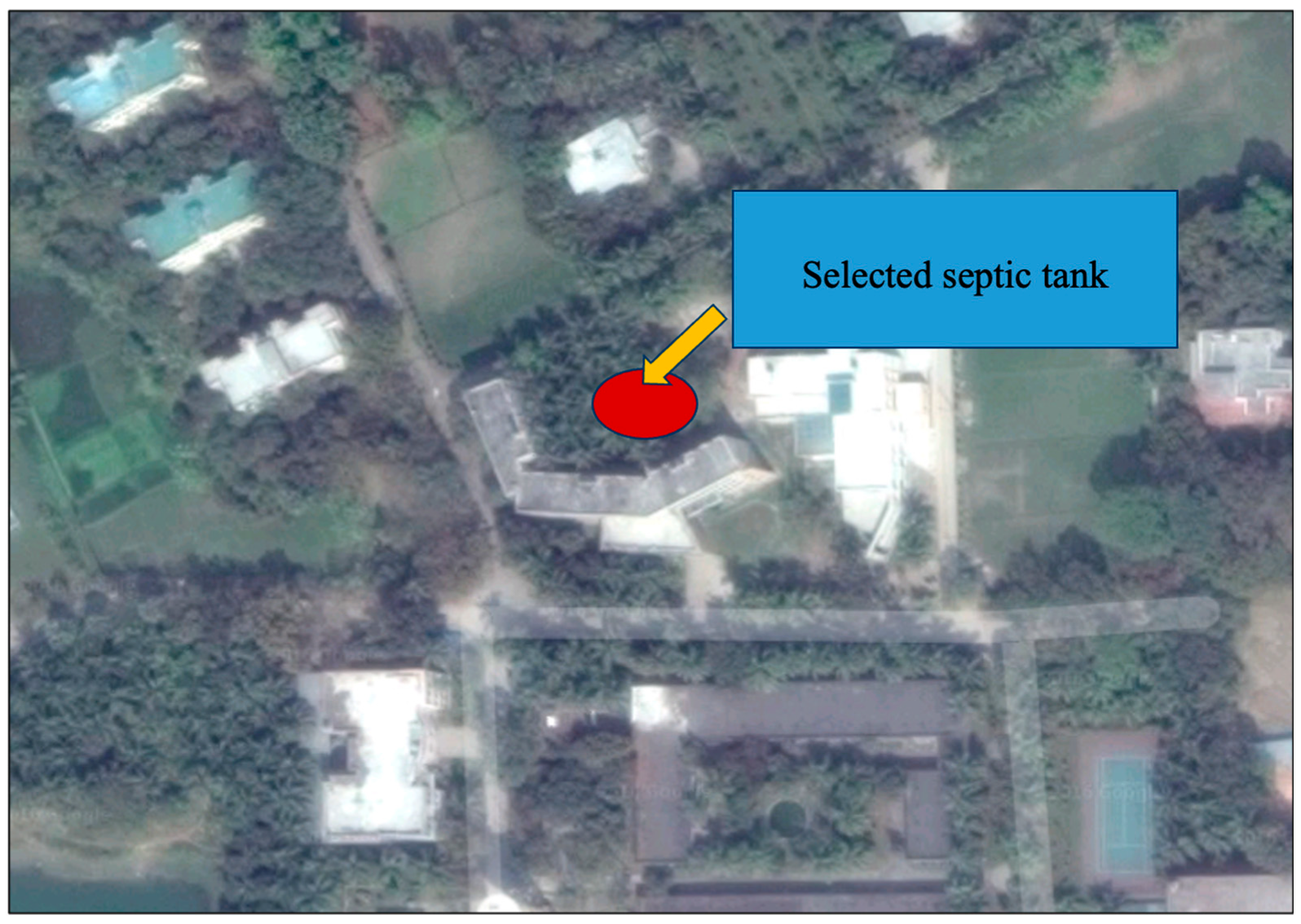
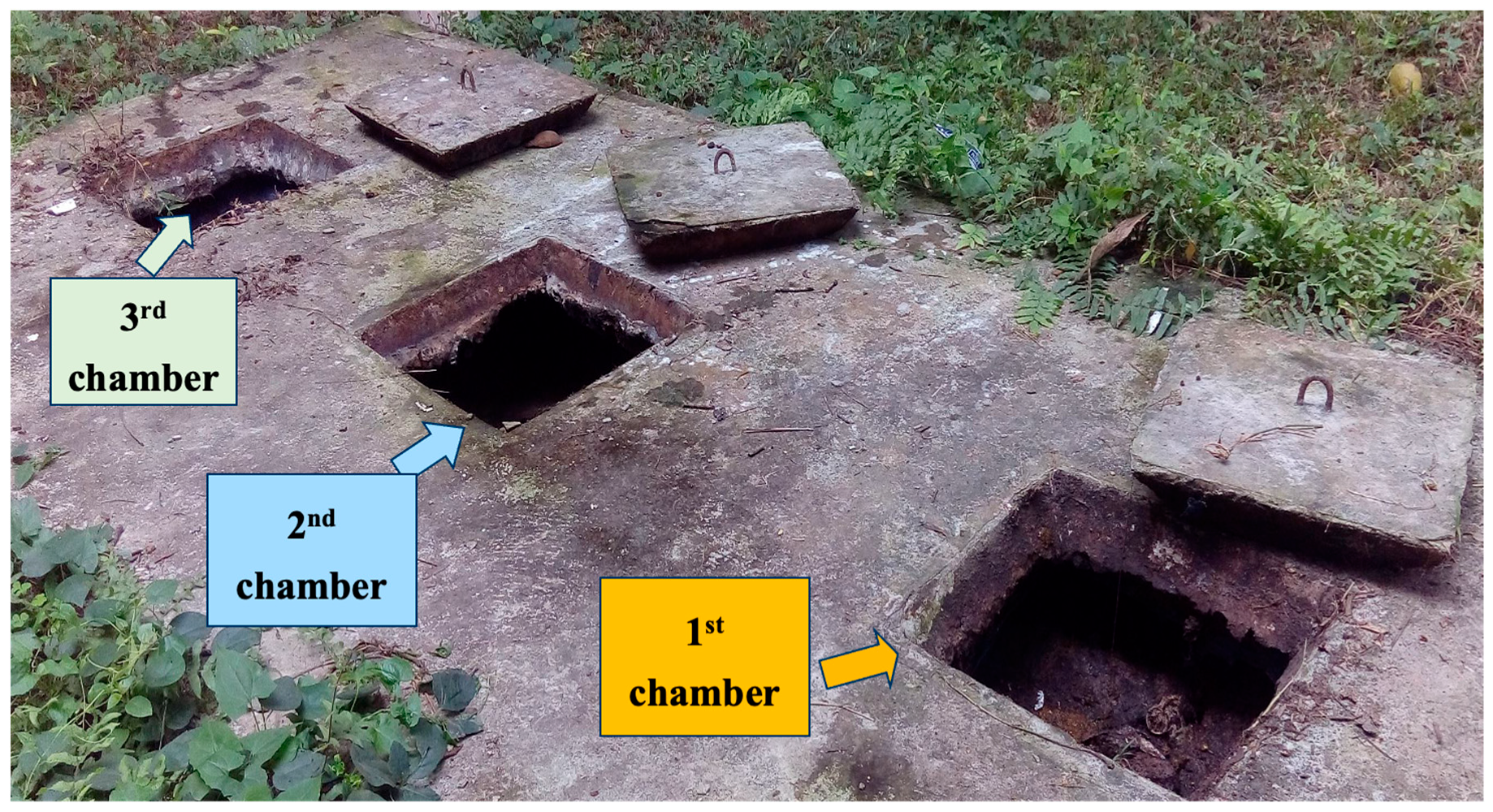
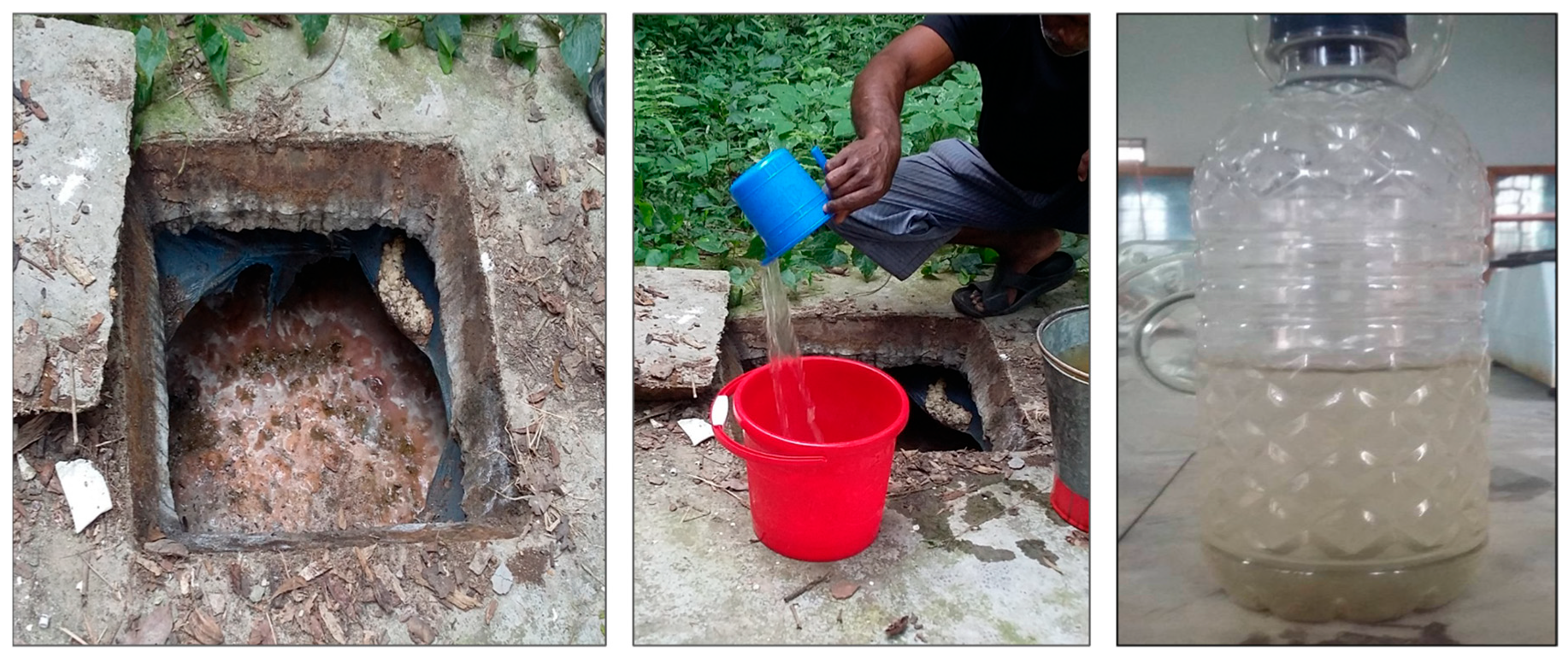
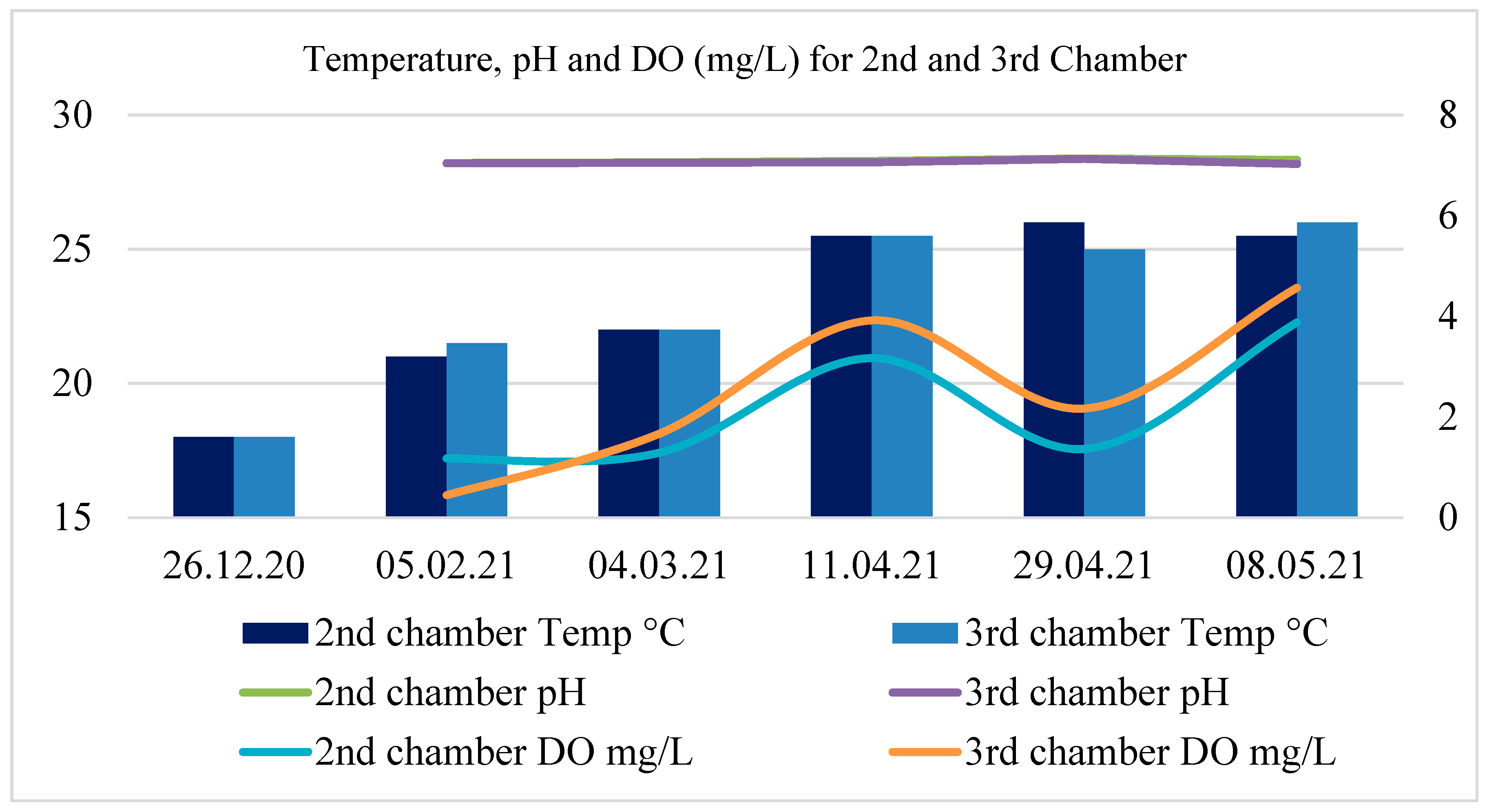

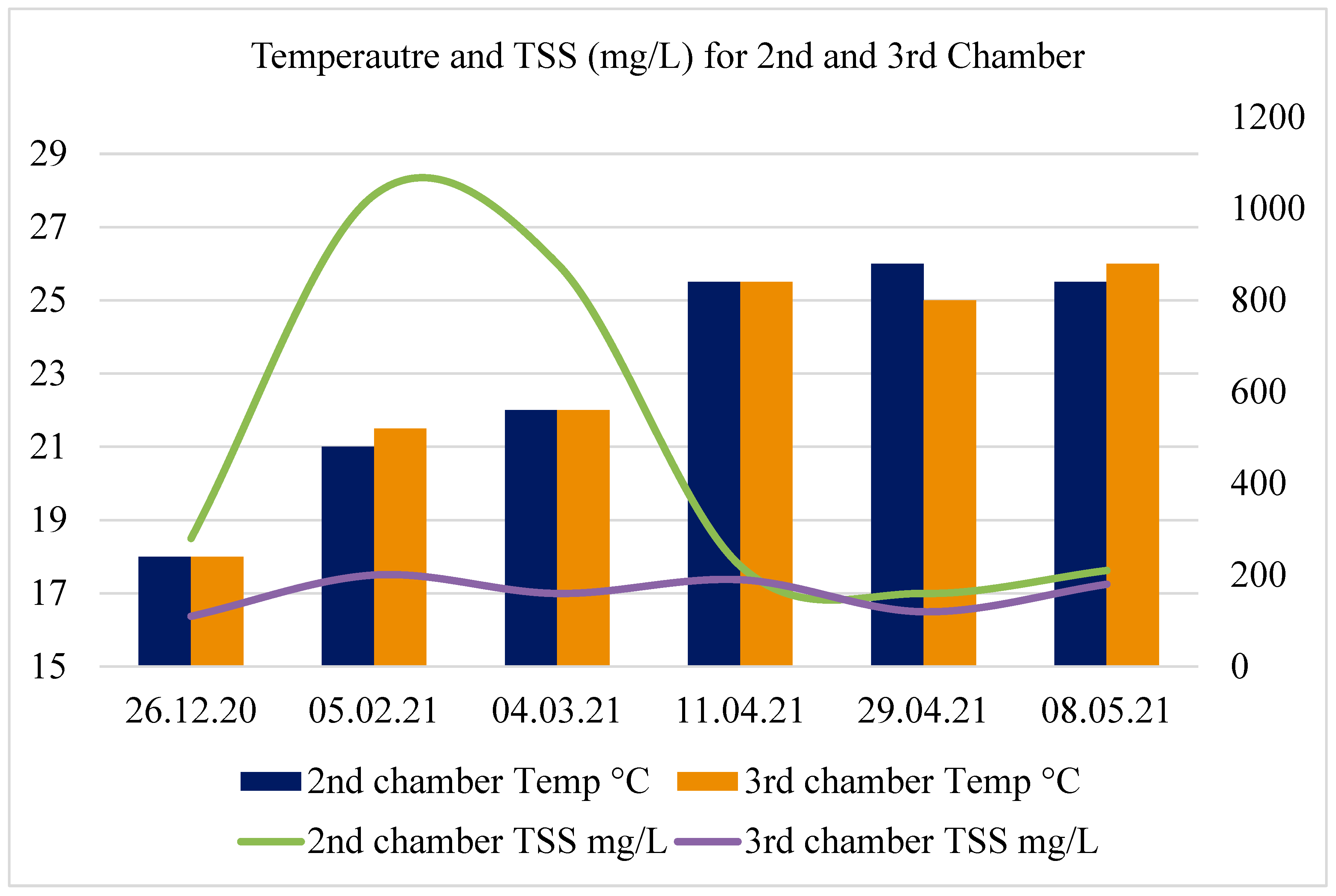
| Parameters | Operation Conditions | Marginal |
| Alkalinity, mg/L as CaCO3 | 2000 | 1000-1500 |
| Gas Composition Methane, % volume | 67 | 60-65& 70-75 |
| Carbon dioxide, % volume | 32 | 25-30 & 35-40 |
| Hydraulic retention time, days | 13 | 7-10 & 15-30 |
| pH | 7.1 | 6.6-6.8 & 7.2-7.6 |
| Temperature, Mesophillic | 33°C | 20-30° & 35-40°C |
| Temperature, Thermophillic | 55°C | 40-50° & 57-60°C |
| Volatile acids, mg/L as acetic acid | 400 | 500-2000 |
| Total Suspended Solids (TSS) Biochemical Oxygen Demand Chemical Oxygen Demand Total Nitrogen as N (TN) Total Phosphorus as P (TP) Oil and Grease |
15200 mg/L 4820 mg/L 32500 mg/L 548 mg/L 230 mg/L 4500 mg/L |
| 2nd chamber | 3rd chamber | |||||||||
| Date | Temp (ºC) |
pH | DO (mg/L) |
TSS (mg/L) |
NO3-N (mg/L) |
Temp (ºC) |
pH | DO (mg/L) |
TSS (mg/L) |
NO3-N (mg/L) |
| 26.12.20 | 18 | - | - | 280 | - | 18 | - | - | 110 | - |
| 05.02.21 | 21 | 7.05 | 1.18 | 1030 | 1.4 | 21.5 | 7.04 | 0.45 | 200 | 0.8 |
| 04.03.21 | 22 | 7.06 | 1.29 | 880 | 2 | 22 | 7.05 | 1.67 | 160 | 1.6 |
| 11.04.21 | 25.5 | 7.09 | 3.17 | 220 | 2.37 | 25.5 | 7.06 | 3.92 | 190 | 2.67 |
| 29.04.21 | 26 | 7.14 | 1.37 | 160 | 3.7 | 25 | 7.13 | 2.17 | 120 | 2 |
| 08.05.21 | 25.5 | 7.11 | 3.88 | 210 | 6.1 | 26 | 7.03 | 4.57 | 180 | 2.9 |
Disclaimer/Publisher’s Note: The statements, opinions and data contained in all publications are solely those of the individual author(s) and contributor(s) and not of MDPI and/or the editor(s). MDPI and/or the editor(s) disclaim responsibility for any injury to people or property resulting from any ideas, methods, instructions or products referred to in the content. |
© 2023 by the authors. Licensee MDPI, Basel, Switzerland. This article is an open access article distributed under the terms and conditions of the Creative Commons Attribution (CC BY) license (http://creativecommons.org/licenses/by/4.0/).





